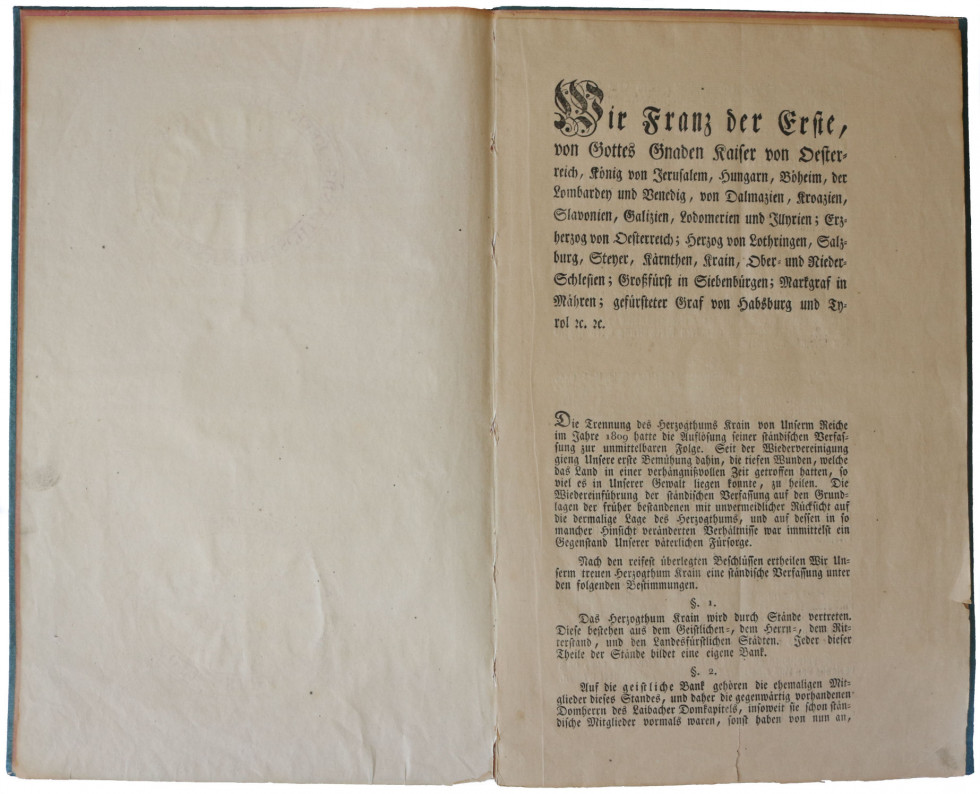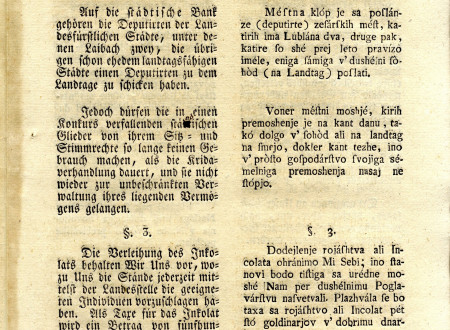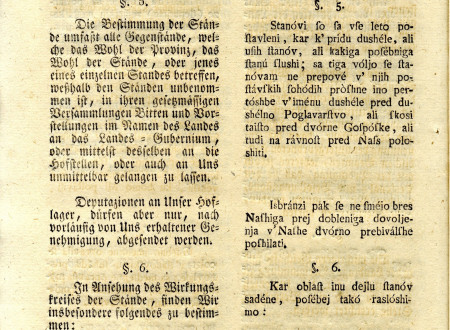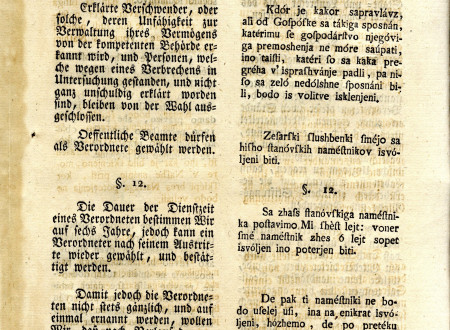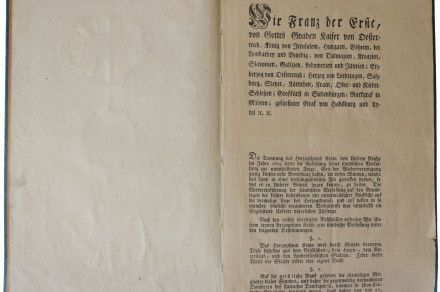The Patent Issued by the Austrian Emperor Franz I on the Restoration of the Constitution of the Carniolan Provincial Estates
Although formed during the 15th century, the Carniolan provincial estates actually reached the peak of their power in the 16th century, when, due to debts, Turkish threat and increased costs of maintaining the Military Frontier, the Carniolan territorial prince was forced to yield to the estates, especially in matters of religion. The estates’ political power derived from their right to approve taxes, they were also in charge of the repartition, collection, and the supervision of the spending of the provincial taxes. After the final victory over the Protestants in the 1630s, the power of the estates began to weaken. During the time of political absolutism, tax approval became a fairly routine task. Though the Carniolan provincial diet continued to discuss military and tax matters, its chances of actually obtaining the emperor’s concessions were rather slim. The reforms implemented by Maria Theresia and Joseph II furthermore pushed the estates out of the administration and judiciary. They no longer played a significant role in tax assessment and were only informed about the emperor’s decisions in such matters. Although retaining their structure, the estates were only allowed to decide on matters of minor importance and to elect their officials. Emperor Joseph II even stopped summoning provincial diets and dissolved the commissioners’ office. Following his death in 1790, the work of the provincial diet was resumed and new estates boards and commissionaires were elected. The estates, though, had no real power and their scope of work was limited and supervised, financial affairs were dealt with by the court accounting authorities. They became nothing more than a social institution until their dissolution by the French in 1809/10.
After the departure of the French, who included Carniola in their Illyrian Provinces (1809-1813), a careful restoration of the Austrian authority ensued. Eight years after the dissolution of the provincial estates, the imperial patent restoring the so-called “estates’ constitution” was issued as well. The patent as a print in German is kept in our collection of deeds, but more common was the bilingual, German-Slovene, version of the text, of which several copies are also kept at the Archives of the Republic of Slovenia.
In the patent the Austrian Emperor Franz I acknowledged the fact that the French separation of the Duchy of Carniola from his empire in 1809 led to the dissolution of the provincial estates and that ever since the reunion he had been trying to heal the deep cut wounds inflicted upon the land. The restoration of the estates’ constitution – based on the previous one, but taking into account the changed circumstances – had also been a subject of his fatherly concern. In fact the restoration of the estates had been on the agenda since the spring of 1814. Different propositions were on the table, among them also the proposal to form joint estates for “Illyria” or join estates for Carniola and Carinthia, since the latter two at the time comprised one provincial government (Gubernium). Some of the high-ranking officials opposed the idea of the restoration of the estates in Carniola, believing that state bodies could perform the administrative operations with significantly lower costs that the estates. The emperor nevertheless decided that estates should be formed for each province separately. We should point out here that in Styria and Carinthia (Klagenfurt district) there was no discontinuance of the work of the estates, since the two provinces were not part of the French Illyrian Provinces. Their structure remained the same as it had been determined after 1790.
The Duchy of Carniola was to be represented by the following four estates (curiae): prelates/clergy, lords, knights and (provincial princely) cities. Included in the clerical (prelate) estate were the former members of that estate and the Ljubljana cathedral canons (provided they had been members of the estate before its dissolution). The patent also stated that, in addition to cathedral provost and dean, two cathedral canons were to be elected, who from then on were to take place in the clerical curia on behalf of the cathedral chapter. The nobility curia consisted of princes, counts and barons, and the knight curia of knights. The obtaining of “seat and vote” in these two curiae depended on a candidates’ noble titles, on the fact whether their properties were entered in the Carniolan landed property register, on their incolat and their coming of age. Should a member of the estates find himself involved in bankruptcy procedure, he had no right to his seat and vote during the ongoing bankruptcy procedure and was unable to freely manage his real estate. Incolat (a type of homeland right, admission into the societies of knights and landed gentry, translation from the patent’s dushelno rojaʃhtvo) could only be awarded by the emperor, but the estates, through the provincial government (Gubernium), could nominate the individuals who they believed were suitable for this privilege.
The curia of provincial princely cities included the representatives of such cities, with the city of Ljubljana having two representatives, and the rest of the cities, which had been members of the estates before their dissolution, having one representative each.
The estates dealt with all matters pertaining to the well-being of the land and the estates. They made formal requests and complaints on behalf of the land, submitted them to the provincial Gubernium, which communicated them to the Austrian court or to the emperor personally. The core of their (non)jurisdiction was captured in the emperor’s statement included in the article 6: I myselfreserve the right to levy taxes … I shall, however, notify the estates yearly about my decision regarding property tax by means of a separate postulate … It was up to the estates then to ensure rightful repartition of taxes across the land and to see to it that the total sum was not exceeded and that regulations were being observed while doing so; they were also responsible for the keeping of proper record – land tax register. The estates have no influence over tax collection nor over the decision regarding a possible tax increase. As a consolation, they were allowed, through provincial and court authorities, to nominate candidates for various posts in Carniolan noble institutions and for prebend and to appoint lower-ranking officials of the estates, but in performing the latter task they had to be careful not to exceed the quotas determined by the emperor regarding the number of the staff and the money allocated for their payment.
The estates adopted their most important decisions at their provincial diets, whereas current affairs were carried out by the commissioners’ office. Both of these bodies were presided over by the governor. A diet usually took place once a year, on the day set by the emperor himself. Extraordinary sessions could only be convened when there was some extraordinary issue to deal with and only with the consent of the emperor. The emperor also had the right to disband a diet and had to confirm the decisions adopted by the estates at their diet in order for such decision to come in force.
Commissioners’ office had four members (one from each estate), a secretary, staff, and work instruction. Each estate elected its member for the office separately. The elected commissioners and the secretary then needed to be confirmed by the emperor. The candidates for the commissioners from the first three estates needed to have their property entered into the landed property register, they could be public officials, but never well-known spenders or persons, whose incompetence in managing (their own) property had been recognized by the authorities, and by no means those against whom criminal proceedings had been brought and had not yet been proven innocent.
An interesting solution was offered for the commissioners’ (first) six-year term. To prevent all four members of the committee to be simultaneously replaced after the finished term, the members had to draw lots (durch das Loos) after the first three years and thus “get rid of” two members, who had to resign and let their posts be occupied by newly selected members from individual estates.
Members of the lords and knights curiae whose names had been entered into a special register of nobility were given permission by the emperor to wear a special uniform introduced prior to 1809. They could also apply for various posts in noble institutions and for prebend. Such personal rights were retained even by some of the former members of the two nobility curiae who at the time of the new constitution did not possess sufficient funds and property: they were, however, prevented from taking part at provincial diets, until they acquired property entered into the Carniolan landed property register.
Finally, the emperor announced the first session of the newly formed provincial diet which was to take place on March 18, 1819. At that session, there would be a solemn “introduction” of the estates and election of the commissionaires and their secretary. Before the first session, members of the first three estates had to demonstrate their compliance with the requested conditions, and representatives of the cities had to be elected.
The patent on the restoration of the Carniolan estates was printed in two languages, with side by side German and Slovene texts. It is certainly not the first time that it is somewhat easier for us to understand the German column than the Slovene one. Viktor Supan, who at the end of the 19th century summarised the text of the patent, commented that the regulations translated for the land of Carniola during the reign of Maria Theresia by a professional translator and historian Linhart, were from the linguistic point of view much better than the one presented here, which supposedly was translated by Vodnik.
The patent was a legal act with no real substance. Carniolan estates had basically no real power of decision-making, they were mere shadows of their former self, a “living corpse” as referred to by Sergij Vilfan. They somehow managed to live through the revolutionary year of 1848 before being completely dissolved in the Austrian lands by 1861.
Andrej Nared


